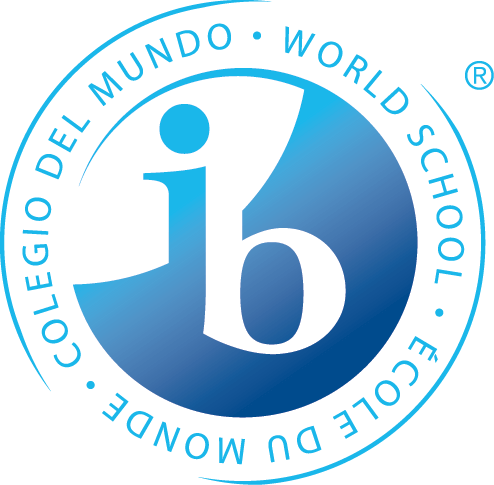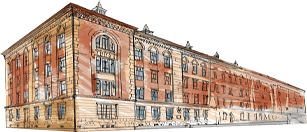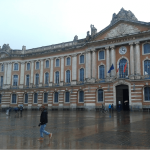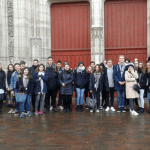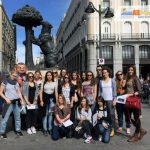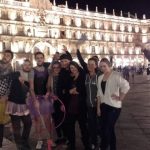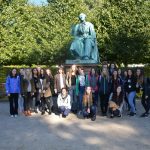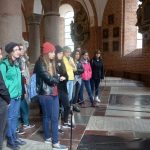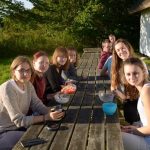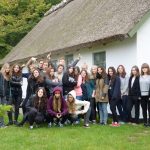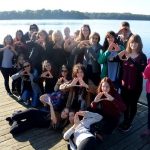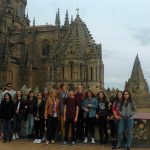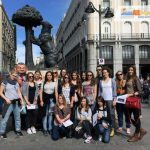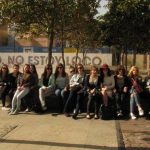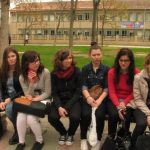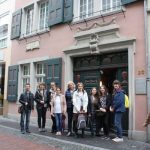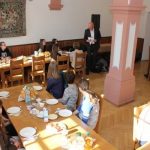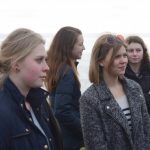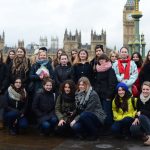Spanish language lovers visiting Andalusia
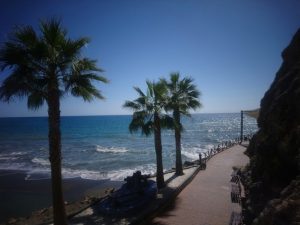 |
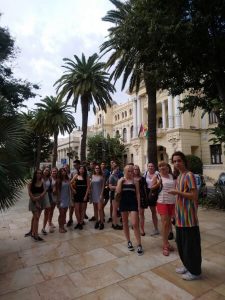 |
Andalusia is a region of Spain known for flamenco, good food, siesta and sun. The Mediterranean climate is conducive to studying in a quiet rhythm, without unnecessary stress, rush and breaks, contemplating art and the local nature. The Spanish language school, which was attended by a group of twenty VILO students, is called “La playa” and, as the name suggests,
located right on the beach. Each student, as soon as they get tired of studying, looking up from the book, will encounter the soothing blue of the Mediterranean Sea. The promise of spending an afternoon at the beach will seem tempting, and at the same time encourage you to complete the ser and estar exercises, which will suddenly stop being so scary.
The food, prepared especially for us in a nearby chiringuito, tastes delicious, even though not everyone likes jamón serrano or vegetable salad. The waiter serves us with great attention, and the chef checks if everything suits us. Always smiling and polite, they wait for us with lunch and dinner at a long table, set especially for us, at which we feast, just like real Spaniards. An additional attraction during meals is that
that everyone can test their skills by ordering dishes and drinks in Spanish.
We not only learn, eat and rest, but also visit. Malaga is a port city with huge ships that we admire every day. The Betitz Mountains on one side, the Mediterranean Sea on the other, and the Alcazaba and Gibralfaro Castle rise above the city. We contemplate a landscape bathed in sunlight. At the foot of the castle we find the ruins of the Roman Theater. We walk the streets discovering squares, churches and museums. One thing was of particular interest to us.
It was in this city that the famous painter Pablo Picasso was born. We watch his works collected
in a beautiful typical Andalusian house with patio. We also enter a huge cathedral where a choir concert is currently taking place. Delighted with what we hear and see, we stay there for a long time. After the spiritual digestion, it’s time for a meal. We eat dinner in a typical tapas bar.
The highlight of the program is a visit to Granada and a visit to the famous Alhambra, a stronghold of the Moorish caliphs. This extraordinary building and its history captivate us. We breathe the atmosphere of this enchanted place and take thousands of photos.
We also visit the town of Rincón de la Victoria, where the Cueva del Tesoro Cave of Treasures is located. It is the only known cave in Europe (and one of three in the world) that was entirely created under water. We get there on foot, along the seaside promenade in full sun.
At the end of the course, we receive diplomas confirming the improvement of the Spanish language. Our Spanish teachers send kind words to us and give us lots of compliments about our commitment in the lessons, interest in the topics covered and the rapid pace of learning. It remains to believe that we will also be appreciated after our return
2017/2018 school year
Exchange with Fontainebleau in France
Welcome to the Benjamin school and the customary exchange of flags.
On April 17, 2018, the time has come for us, we went to Liege. On the first day, the students showed us the school. We were offered a great dinner, we had the opportunity to try the famous Belgian fries and meatballs, for which we even got a secret recipe. We also attended a Spanish lesson and we had a great time.
On Wednesday we went for a walk around Liege. It’s a beautiful student town very close to Brussels. The magnificent main station impressed everyone, and the Church of St. Jakub was shown to us by a lovely guide. In the evening, we met in smaller groups to get to know and taste the life of Belgians of our age.
Thursday is a visit to the European capital – Brussels. It is a city of murals, street art and modernity. In addition to the most important monuments and must-see stops such as Manneken – Pis, we also visited the Comic Book Museum. We learned that our Belgian friends have read various types of comics from an early age and that it is a very important matter for them. We also tried delicious Belgian chocolate. We traveled to Brussels and back by train, at the same time we had the opportunity to see the already mentioned railway station in Liege and the one in Brussels.
On April 20, we visited the Kaserne Dossin museum commemorating the victims of the Second World War. As in all the other places we visited, we could choose to visit in English or French. In the evening, our Belgian correspondents organized a party for us in the splendid garden of one of the exchange participants. It was a chance to strengthen contacts and, of course, to practice one’s language skills.
On Saturday, we were able to sleep a little longer. Some went skating (the ice rink was located in the mall), others played laser paintball. Still others went with their correspondents, for example to a scout camp. In the evening, we all met at school and had the opportunity to watch a play by both students and teachers on the occasion of the theater week that was just taking place in Liege.
On Sunday morning, we went for a walk around La Batte market. Later, our correspondents organized the day for us.
Monday is the day of departure, in the morning we gathered in the school parking lot and headed for the airport.
Exchange with Belgium – stay in Krakow
Please visit the photo gallery
On March 21-27, 2018, we had the pleasure to host a group of 15 Belgians from the Belgian city of Liege with their lovely professors. The exchange tutors on the Polish side were irreplaceable prof. Lichoń and prof. Szczepankiewicz.
They flew in on Wednesday afternoon and came straight from the airport to the school. We welcomed them with snacks and showed them around our high school, introducing here and there the history of both the school building and Kazimierz.
We started Thursday with the morning collection at Wawel. Belgians visited, among others royal castle, St. Mary’s Church and the Barbican. After the trip, they started an English lesson with the reliable prof. Pacyna, thanks to which Poles and Belgians could integrate and learn a little more about their countries.
On Friday, we met in front of the school in the morning, because at 6 o’clock the Belgians visited the Concentration Camp in Oświęcim on that day, and then went to visit our Jewish district, Kazimierz, with the Schindler Museum.
We spent Saturday with the Belgians in Zakopane, where we watched, among others the first Zakopane church and cemetery in Pękkowy Brzyzek. We ate a traditional Polish dinner at the “Żabim manor” and took the cable car to Gubałówka. The weather was definitely good for us, the photos from this trip are exceptionally beautiful.
The Belgians spent Sunday in Polish families, many of us went bowling together, others spent time with the family. We showed our guests how we spend our free time in Poland and what habits we have in our homes.
On Monday, the Belgians had one more opportunity to take part in classes with prof. M. Muszka, and later went to the Salt Mine in Wieliczka. They were very impressed with the beauty of the representative hall, the one with the magnificent chandeliers. The guests ate dinner underground, which was an additional attraction for them.
We said goodbye on Tuesday, early in the morning the Belgians left for their country, leaving us unsatisfied after their short visit.
Every day after the trips, Polish youth spent time with guests, it was spent on talks and exchanging views and impressions. We shared customs, music and learned each other’s languages. We are flying to our friends in mid-April and we hope to bring back from Belgium as beautiful memories as those with which we stayed at our homes after the visit of Belgian youth.
Sevilla tiene un color especial
Please visit the photo gallery
On 6-13.06.2018, students from class 1h and 2i improved their language skills during a course at the Carlos V school in Seville. It was seven very intense days: classes at school, flamenco workshops and kilometers long walks around beautiful Seville and Cordoba. But there was also time for siesta in the hammock or in the jacuzzi on the terrace, there was delicious Mediterranean food and Andalusian chill.
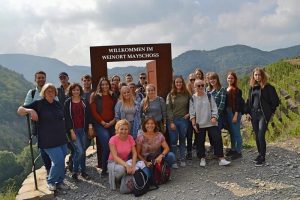 |
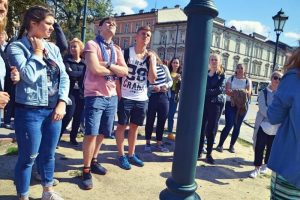 |
Exchange with Ahrweiler (Germany) – September 21-28, 2017
On September 21-28, twelve second and third grade students under the supervision of prof. Ewa Nycz and prof. Paulina Pacyna went to the town of Arhweiler near Bonn to visit her German colleagues who had previously hosted in Krakow.
Our adventure began in the afternoon of September 21, when we got on the bus full of energy. We were there the next day around 8 (3 hours before the planned arrival). We were immediately greeted by our smiling colleagues from Germany and the school’s headmaster. We had a delicious breakfast together in a room specially prepared for our arrival. After a short tour of the school, we were able to go to our families for a well-deserved rest. In the evening of the same day, we had the opportunity to participate in an unusual and perfectly prepared BIGBAND school concert. Of course, our talented colleagues from Germany sang and danced. The next day, we visited the local winery and the beautiful, breathtaking vineyards that Ahrweiler is famous for. Sunday was a family day, during which we had the opportunity to spend time in a nice and interesting way with our German or German relatives. On Monday morning we set out to conquer Cologne. The first thing that catches your eye in this extremely charming city is the huge, wonderfully designed cathedral with lots of colorful stained glass windows and an interesting history. An interesting fact is that some part of the cathedral is always under renovation and it is said that when the renovation works are completed, we can expect the end of the world. The next day was just as active as we went to Trier – a city with a history going back 2,000 years. We saw the ruins of the city there, about which the guide told us in Polish. We returned to Ahrweiler in the evening to celebrate our unfortunately last evening with our German colleagues. On Wednesday at 8 everyone showed up at school packed, but we didn’t have to part with the Germans yet. We went for a long walk to the nearby bunkers, which we also visited with a guide. Then it was time for the last moments in the city, shopping, and unfortunately at 2:30 p.m. we had to say goodbye to our colleagues. The return trip took a little longer than planned, but that didn’t matter as it allowed us to remember unforgettable moments in Germany. Some of us liked it so much that they plan to come back to Ahrweiler as soon as possible and this time for longer …
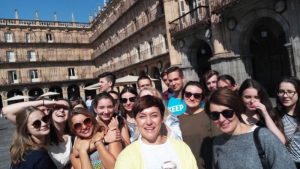 |
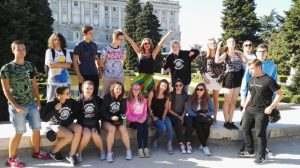 |
VILO students on a language course in Salamanca, September 18-25, 2017.
Please visit the photo gallery
Intensive language learning, dance and gastronomic workshops, tasting Spanish tapas, visiting the monuments of Salamanca and other Castile cities, a visit to Madrid – all during the next stay of VILO students at the Mester Academy.
All this, combined with the hot sun, cloudless skies and the unique ambiente of Salamanca, is a perfect recipe for a successful start to the school year.
2016/2017 school year
EXCHANGE WITH THE TULLE -7-14.06.2017
10th exchange with the Sagrado Corazón de Jesús school. Class 2h3, Zaragoza 23-29.03.2017
Please visit the photo galleryZapraszamy do galerii zdjęć
Exchange with Genoa – May 9-16, 2017
Please visit the photo gallery
From 9 to 16 May 2017, seventeen first and second graders under the supervision of prof. Katarzyna Borejczuk and prof. Paulina Leśniak went to Genoa to visit her Italian correspondents, who had been hosted in Krakow a month earlier.
On May 9 at 8 p.m. we landed at the airport in Bergamo, from where we took a coach to Genoa, 200 kilometers away. At around 11pm we arrived in the city, where we were greeted with a traditional Genoese focaccia. The next day at 9 o’clock we had a meeting with the headmaster of the Sandra Pertini and a concert prepared by the students of that school. In the afternoon, the art history teacher showed us around the city, telling us about the architecture and interesting facts related to Genoa. The next day, many attractions awaited us: we took a train along the Ligurian coast to the town of Camogli, where we had a boat trip to the San Fruttuoso Abbey, picturesquely situated on a beach hidden among the rocks. Then we sailed to Portofino and ended the cruise in Santa Margherita Ligure, where we walked on the world’s longest carpet, 6.5 km. The next day we went to the Genoese aquarium, which is the second largest in Europe. There, we saw what feeding sharks looks like, we could touch the rays and admired acrobatic performances of dolphins. On Saturday, we went for a walk along the Anita Garibaldi promenade, where there were plaques commemorating the stay of Józef Piłsudski and Maria Konopnicka in Nervi, a former health resort, today a district of Genoa. We finished the walk in the gardens of Nervi, admiring the magnificent rose garden. After the weekend, on Monday, all students took part in lessons until 1 p.m., and we spent the afternoon on the beach near the monument commemorating the Expedition of a Thousand led by Garibaldi. In the evening we attended a farewell party that took place at school. After the school disco we went to Castelletto, a district from which you can admire the view of the port and the whole of Genoa. The next day we played a rematch volleyball match. After lunch, at 3pm, we left our Italian friends and the fabulous Ligurian landscapes to go from Genoa to Bergamo airport.
Thank you for a great week and see you!
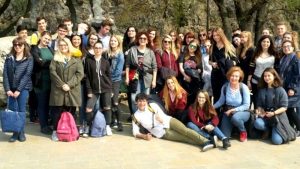 |
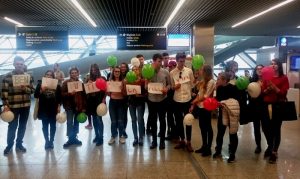 |
Exchange with Genoa: welcome Italian students!
On Tuesday, April 4, the representation of our Lyceum welcomed a group of students from Genoa.
Thanks to the attention to detail and careful preparation, it was loud about us even on the airport website! https://twitter.com/KrakowAirport/status/849258676175155201
We started the exchange with a joint walk around Krakow. There are still many attractions ahead of us.
We wish our new Italian friends a pleasant stay!
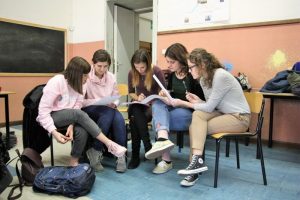 |
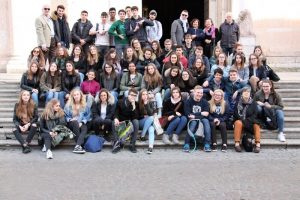 |
Exchange with Liceo di M. Gioiado in Piacenza – March 6-11, 2017
Please visit the photo gallery
On March 6 – 11, 2017, under the supervision of prof. Grzegorz Harabasz and prof. Wojciech Rak, we set off for an exchange to the Italian town of Piacenza.
On Monday, March 6, in the morning we all arrived at the airport to bravely face the hardships of the journey. It did not last too long in itself – an hour and a half on the plane, a moment on the bus … and here we were, in front of the Liceo di M. Gioia building, romantically located near the famous Palazzo Farnese.
The promised Italians were waiting for us there. After a short refreshment and careful examination, we went to the homes of the families assigned to us to eat, unpack and tighten our bonds.
The second day of the exchange was mainly in Mantua, where we had the opportunity to admire the Palazzo Te, a palace complex in the mannerist style. It was built in the 16th century by order of Frederick II Gonzaga and thanks to the courtesy of Giulio Romano, an architect skilled in his art. After looking closely at the center of Mantua itself, we returned to Piacenza to spend the evening there in the company of Italian colleagues.
On Wednesday we were catching up at school by distilling alcohol from wine
and philosophizing together. We also saw Piacenza very carefully and had a meeting with the mayor of the city himself.
The highlight of the program was Thursday’s trip to Milan.
In the Pinacoteca di Brera gallery, we had the opportunity to see, for example, Il bacio, the most famous painting by Francesco Hayez.
On the last day of the trip, we visited the mysterious Palazzo Farnese, a memento of the reign of Prince Ottavio Farnese over Piacenza. In the afternoon we went to Rivergaro. In honor and glory to the former heroes, on a beautiful sunny day, we reconstructed the memorable battle of the Romans with the Carthaginians at the Trebia. Fortunately for the Punic troops, history graciously decided to repeat itself. 2: 0 for Carthage!
After the battle, we went to a farewell dinner to celebrate
and summarize the past few days. On March 11 in the morning we said goodbye to the Italians effusively, but not too heartily – we will see you again this month! Non vedo l’ora!
Text: Sara Kolańska, class 2h3
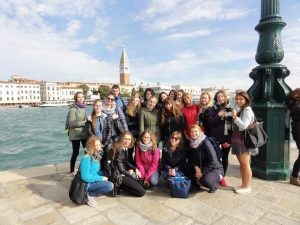 |
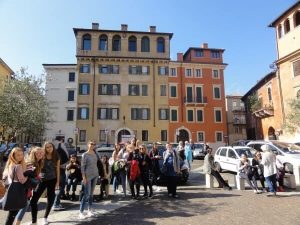 |
Exchange with Verona – October 2016
Please visit the photo gallery
EXCHANGE WITH VERONA
Tutors: mgr Paulina Leśniak, mgr Katarzyna Borejczuk
On October 6, 2016, we, second and third grade students from Secondary School No. 6, arrived at the Balice airport to go on an extraordinary and charming journey to Verona. After an almost two-hour flight, we arrived in Milan, where we were picked up by teachers from Liceo Linguistico Niccolò Copernico in Verona. Together with them, we went to the magical city of love of the most famous lovers – Romeo and Juliet. There, in front of the school building, our hosts were waiting, with whom we went home.
We started the next day with visiting one of the largest Roman amphitheatres – Arena and the Basilica of San Zeno Maggiore considered to be one of the greatest achievements of Romanesque architecture in Italy. There were so many attractions that Professor Cristina planned for us that it is impossible to describe them all! After an intensive sightseeing tour, Italian friends took us home.
On Saturday morning we went to high school to see how the local school works. For us, students of Polish schools, it may be a bit strange, but Italians go to school from Monday to Saturday! Right after the lesson ended, we went back to our families to prepare for a chocolate festival in the nearby town of Soave. Tasting a variety of confectionery products was a great experience for chocolate connoisseurs and its opponents, because there everyone found something for themselves. Then we went to our homes and stayed there until Monday.
Saturday evening and Sunday were different for everyone. Some spent time with their Italian families exploring Verona and its surroundings, watching Pirates of the Caribbean or playing Monopoly, others had karaoke, and still others went to a birthday party.
On Monday we took the train to Venice. We liked the winding and narrow streets the most, as well as the Grand Canal, on which we had the opportunity to ride a gondola. After eating meals in atmospheric restaurants and having free time, we visited St. Mark. From the observation deck of the temple, we had an unearthly view of the square below and the entire city. Then we went shopping on one of Venice’s most touristic streets. After a day full of attractions, we returned to Verona tired.
The next day, together with the Italian participants of the exchange, we went to the beautiful and picturesque Lake Garda. Before relaxing on the sandy beach, we visited the charmingly situated town of Sirmione, the only entrance to which is through the gate of an impressive castle belonging to the Scaliger family. The city was known to be very touristic, thanks to which we acquired many interesting souvenirs. On the same day, we also visited the remains of one of the largest Roman estates known as Grotte di Catullo.
On Wednesday, we went to Mantua to visit, among others, the Palazzo Ducale in a medieval atmosphere. Fascinated by this building, we also visited Palazzo Te, full of beautiful frescoes. At the end of this fruitful day, some of us spent at the lake, while the rest of the students did their last shopping. In the evening, already in Verona, we all met for an Italian dinner. By dancing integration, we introduced ourselves to the atmosphere of saying goodbye. After such a meeting, we got close to each other, we had an even greater problem with leaving wonderful Italy. We don’t say goodbye, but goodbye! See you in Cracow!
Karolina Chyb and Adrianna Baran (class 2c) wrote down their impressions
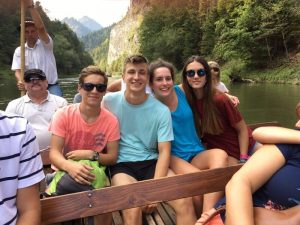 |
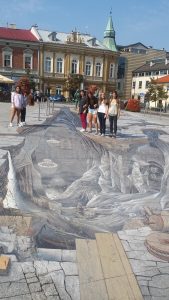 |
Exchange with Zaragoza – September 2016
Please visit the photo gallery
In the second week of September this year, we hosted at our school a group of young people from Zaragoza, from the “Sagrado Corazón” school.
As part of the international school exchange, Spanish students and their accompanying guardians had the opportunity to get to know our beautiful city and admire the attractions of our region. Together with our guests, we went on a day trip to Frankówka. We visited the city of Nowy Wiśnicz and visited the house where Jan Matejko lived. We ended this trip by making dumplings together and feasting by the fire, with traditional sausages, baked by each of the participants. During the week-long visit, the Spanish youth also visited the Salt Mine in Wieliczka, the Concentration Camp in Oświęcim, Wawel, the Cloth Hall and the St. Mary’s Tower, from where our guests could admire the beautiful panorama of Krakow and the surrounding area.
We spent many nice and unforgettable moments together, we hope that the friendships made will stand the test of time and that we will meet again.
Organizers:
Anna Kwiecińska-Chmiel
Magdalena Śmigasiewicz
2015/2016 school year
Expedition to the Philippines
Please visit the photo gallery
In the second half of May 2016, a group of thirteen students set off on a 19-hour flight to Manila, Philippines. They were accompanied by Mrs. Aneta Wojtaszek, a French teacher, the organizer of the expedition, and Mrs. Iwona Fedan, deputy director. The inviting party was Lycée International de Manille, and more precisely Chrystelle Capdecomme, a teacher of French language and philosophy, who two years ago had a teaching training at the 6th High School.
We hereby begin a series of photos from the next stages of our journey.
Exchange with France
This is the fourth visit of the students of the VI Lyceum in Fontainbleau, France. This charming place near Paris delighted once again. Not only the sightseeing of Paris and the charming Fontainbleau was remembered by all of us, but also the smell of croissants, the taste of cheese, but most of all the smile that did not go out during this stay. Permanent and full of positive emotions friendships were made. In turn, students from France brought to Krakow a lot of positive energy and a desire to learn about Polish culture and customs. The turn of March and April turned out to be a perfect time to visit both countries, because the weather was kind to us and the whole exchange was certainly the sweetest so far.
We invite you to participate in this exchange in the next school year!
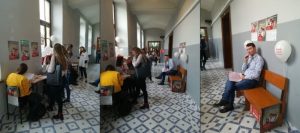 |
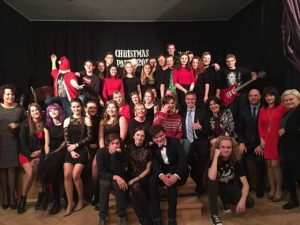 |
International exchange VI High School in Krakow and Sainte-Marie des Champs Secondary School in Toulouse 9.02 – 16.02.2016.
Please visit the photo gallery
A great adventure with undeniable educational and cognitive value, which was a visit to Toulouse, has ended. Students returned to Poland full of new impressions and convinced that this is not the definitive end of this adventure, and the friendships made will survive the test of time and distance.
The purpose of each exchange is to get to know people, culture and place, as well as to exchange experiences and information, and meet the linguistic, representative and organizational requirements. And this time we managed to implement all the assumptions, at the same time opening the way to the full discovery of the beauty of French regions, their monuments, art, and places not related to traditional tourist routes – favorite cafes, small and peaceful shops, full of violet cosmetics and sweets, or places French youth rest.
When a group of Polish youth landed at the Toulouse-Blagnac airport, the stress of meeting new people, seemingly completely different and distant from them, was mixed with the desire to experience a different culture and customs. The fears turned out to be unfounded, because the French group, with its openness and smile, tried to facilitate acclimatization, at the same time bringing the realities of everyday life closer and showing the beauty of its charming town, called “la ville rose” – a pink city (due to the large number of buildings built of red brick) . Situated in southwestern France, the city is a cluster of cathedrals and churches, as well as an important cultural and scientific center, as the students were soon to discover.
The main points of the program of Polish youth’s stay in France:
February 9 – On Tuesday, an excited group of young people from the VI Liceum im. Adam Mickiewicz in Krakow gathered at the Krakow-Balice airport to begin her week-long journey. On board a Brussels Airlines plane, it flew to Brussels, then went to its proper place of stay – Toulouse. After a long and tiring journey, high school students could finally meet with French families and, despite the late hour and driving rain, lively tell about their impressions.
February 10 – After a warm welcome from the high school management, it is time for a Polish-French sightseeing tour of the city. Polish students with their accompanying teachers and correspondents had the opportunity to see and visit the monastery of St. Stephen’s Cathedral, the Pont Neuf bridge and the town hall located on the square du Capitole – the undisputed symbols of the city. The students of the French school told about each of the aforementioned monuments, as well as other visited places, reading previously prepared notes in French and Russian, which met with the warm approval of Polish youth. After completing the route planned for Wednesday, students from Poland had free time, which they spent with their correspondents.
February 11 – In the morning, the Polish group waited a specially prepared lesson entitled “Conquering of space by the Russians” carried out by a specialist from AIRBUS. Thanks to the Polish translation, the lecture was also clear to students who did not learn French. After an hour’s introduction to the secrets of the subject, it’s time to explore the high school, a small private school with a truly French, peaceful character. Then the Polish group went to the famous Cosmic Town, a place where you can learn everything about space flights and outer space. The 55-meter rocket “Ariane V”, the opportunity to “learn” the moon walk and the unusual planetarium were not the only attractions of this place full of tourists. After the Polish students returned to school, they were picked up by French correspondents who had finished their lessons.
February 12 – On Friday, Polish students had the opportunity to learn about the mode of study in France, because they participated in the first two lessons of their correspondents. It was not without surprises about the method of assessing and the length of classes as well as the distribution of breaks between lessons – or rather the lack of them, replaced by an hour-long interval in which the French eat a meal comparable in size to a Polish dinner. After the lessons, the Polish part of the exchange went on a tour of the city again, getting to know other corners of Toulouse – with the Basilica of St. Saturnin (entered on the UNESCO list) inclusive. The group, exhausted by a few hours’ escapade, returned to high school to watch a specially prepared performance in French and Russian “Chekhov-Moliere”, with a paper translation into Polish at their disposal. A storm of applause and friendly smiles was caused by the speech of one of the French, who announced the performance also in Polish. The short, but funny and well-prepared speech was concluded with a snack prepared by French peers. Among the usual snacks you could also find specialties of Russian cuisine – incl. dryers and kvass. After an eventful day, Polish students returned with their correspondence
- Getting to know the wealth of history, culture, tradition and monuments of France;
- Promoting respect for other cultures;
- Getting to know the customs and customs of French students;
- Developing language skills through communication in English, Russian and French;
- Intercultural cognition, exchange of information and mutual experiences.
ERASMUS + – NITOK PROJECT
On October 4-9, students of our school took part in the NITOK project of the Erasmus + program. NITOK stands for: National Identity and Tolerance in Olofstrom and Krakow. The main themes of the project are broadly understood national identity and tolerance.
During the project, students of High School No. 6 and Nordenbergsskolan from Olofstrom from Sweden participated in trips to Wieliczka, Oświęcim, city games and visits to the museum. Swedes learned about Polish culture and history, and Poles in April will have the opportunity to learn about the culture of Sweden. All this in order to answer questions during the project – who we are, how tolerance or the lack of it can affect the identity of an individual and how to live in the modern world – so cosmopolitan on the one hand and full of fears and xenophobia on the other hand.
Project coordination: Anna Eastwood, Justyna Wieczorek
AUTUMN IN DENMARK
that is, the report from the return visits of the students of High School no
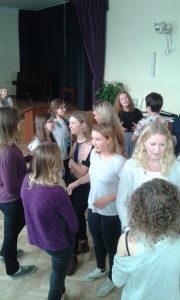 |
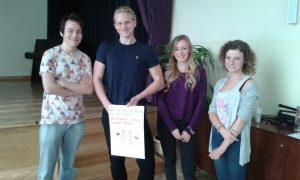 |
On Sunday, September 27, excited and impatient, we showed up for the collection at the building of High School no. VI, to depart towards Denmark at 10 pm. After a long and sleepless night on the bus, we got on the ferry in the German city of Rostock. After the ferry crossing and reaching the town of Sorø, we took a short walk around the Academy grounds, admiring its vast grounds and the lake. Then we went to the forester’s lodge, which was to become our home for the next week, to unpack and rest. After some misunderstandings, each assigned to their own room, eagerly fueled by the rumbling of bellies, we waited for the arrival of the Danes, who treated us to a wonderful dinner.
On Tuesday, after preparing delicious lunches at the academy, we headed for Copenhagen. During the sightseeing and cruise along the canals of the capital, we were accompanied by incredibly perfect weather, which was good from the beginning to the end of our visit to Scandinavia. In the capital, we saw all the places characteristic of this city, such as: the parliament, the palace of Queen Margaret II, her guards, the opera, the mermaid, as well as the newly built Black Diamond library and numerous cathedrals. In the evening, we met with the Danes to see what the Academy students’ quarters look like, and to spend a good time walking and looking at the stars.
Wednesday was a day devoted only to visiting the Academy. As for its terrain, this is something to envy. After visiting the amazing Museum of Physical Instruments, we went to the Science Center which took everyone’s breath away. Surrounded by technical innovations such as: 3D printers and scanners, flight simulators, or the Wilson Chamber, i.e. a device showing cosmic rays, we were stunned. Later, after lunch in the academic canteen, we also visited other buildings such as the medieval church, the old library and the rooms in the main school building. During the day, we also had time to walk around the town of Sorø and visit the local art museum. After a short rest and a meal in the forester’s lodge, we returned to the Academy to learn the traditional dance of Les Lanciers. Having mastered three of its parts, tired but proud of ourselves, we could feel like real students of Sorø Akademi.
The next day was dedicated to visiting the former capital of Denmark – Roskilde. We saw the amazing cathedral that is the burial place of most Danish kings and queens. Then, while walking around the beautiful city, we went to the Viking Ship Museum. On the same day, we went to a gala dinner with the Rector of the Academy. Unfortunately, it was the last time we had the opportunity to talk to the Danes, and although we promised to stay in touch via the Internet, it was so difficult for us to part.
Friday was marked by midnight castles. We drove to the city of Helsingor where we visited the amazing Hamlet Castle – Kronborg. Then, we took the ferry to Helsingborg in Sweden, on the other side of the strait. Unfortunately, only ruins remained of the twin castle, but the view from the top of its tower was unforgettable. Finally, we visited Frederiksborg Castle in Hillerod, where we went for a walk in its picturesque gardens, some even took a bath in the fountain. All castles made an unforgettable impression on our group and many people admitted that it was their favorite day of departure.
We returned to Krakow, to the sounds of the song “Don’t worry, be happy”, very tired, but happy with the trip and sad that we had to leave this amazing country. Richer with unforgettable experiences and wonderful memories, we have come back to reality.
Students from class 2a1: Izabela Zientarska and Julia Musiał
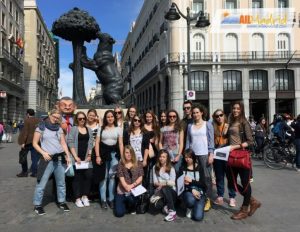 |
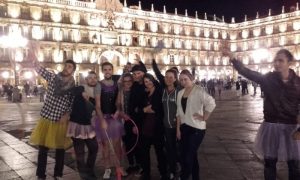 |
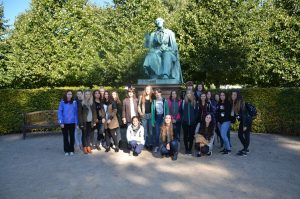 |
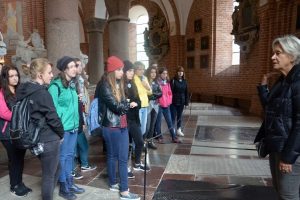 |
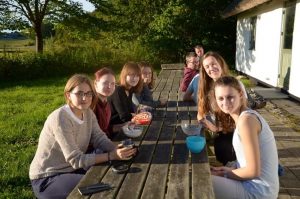 |
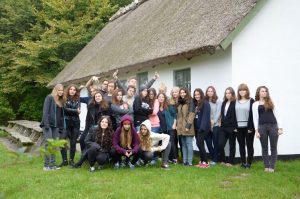 |
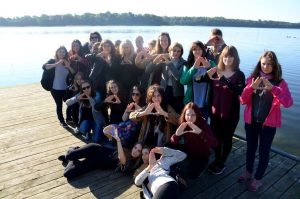 |
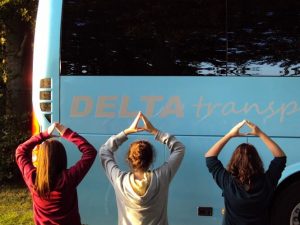 |
Language camp in Salamanca 2015
Hace dos semanas clases 2h1 y 2h2 estuvieron en Salamanca. Nuestra aventura empezó el 8 de octubre de un paseo por Madrid. Para algunos esa fue la primera vez en España.
En Salamanca pasamos allí 8 días maravillosos. Por las mañanas teníamos clases de español. Luego la escuela „Mester” nos organizaba el tiempo (excursiones, talleres de arte o historia, cocina mediterránea, curso de salsa/sevillanas). Aparte de Salamanca visitamos Segovia y Ávila. Comimos diversas tapas españolas, paella, chocolate con churros y unos platos españoles más. Total que regresabamos agotados a nuestras habitaciones hacia las 9 de la tarde. Pero no sentimos tanto el cansancio.
Salamanca resultó una ciudad con encanto. A todo el mundo le gustó y algunos ya decidieron a estudiar allí. Paseando por la capital de Castilla y León teníamos la sensación de que la ciudad se parecía un poquitín a Cracovia, pero claro, no se debería comparar el estilo plateresco, que dominaba en casi cada edificio, con la arquitectura de Polonia. La única cosa que podríamos comparar es la Plaza Mayor. Por qué? Mirad…
Al fin y al cabo guardaremos nuestros recuerdos para siempre y ¡la aventura con el español todavía sigue!
2014/2015 school year
0H1 and 0H2 classes on a language course in Salamanca – 04.2015.
Please visit the photo gallery
In April 2015, students of 0H1 and 0H2 classes participated in a language course in Salamanca, under the supervision of Mrs. Magdalena Śmigasiewicz, Mr. Paweł Przybyła and Mrs. Anna Kwiecińska-Chmiel. Students spent a week in Spain learning Spanish and getting to know Spanish culture, customs and traditions.
Exchange with Zaragoza – April 9-16, 2015
Please visit the photo gallery
The first classes 1H1 and 1H2, a one-of-a-kind Spanish section, traveled to Zaragoza from 9 to 16 April 2015 to discover the secrets of this beautiful city. We struggled with both cultural differences and language barriers.
During this week, making international friendships, learning about cuisines, stories
and the traditions of our friends, we have managed to destroy our borders!
During the exchange, Spanish youth tried to organize their free time in accordance with our interests. Already on Friday we had the opportunity to get to know them a bit better during the Fiesta. During the following days, each of us spent our time differently. Some in the shopping mall – the largest in Europe, where, apart from shopping, we could go climbing, surfing or boating on the nearby ponds. Several of us spent time with our families visiting Zaragoza and its museums. The Goya Museum was especially worth paying attention to, where you could admire the painter’s famous prints. The rest of us – outside the city, visiting the surrounding sights such as Monasterio de la Piedra, Alquezar or in Catalan resorts. The morning hours spent on Spanish lessons were also extremely interesting, where we could see what the classes look like and take an active part in them. In the following days, we visited the Muslim part of the city, including the partially preserved Aljafería Palace and the impressive La Seo Basilica. On a joint trip in the Pyrenees, we saw the medieval monastery of San Juan de la Peña. On the last day, we were able to see El Pilar, the main cathedral of the city related to the legend of Mary, which the apostle James saw on a pole.
Thanks to this week-long adventure, we have plenty of memories that will remain for a long time
in our memory. And our friends come to us in September. We are waiting
forward!
Kalina Dębska1H2, Karolina Kwietniowska 1H2, Patryk Międlar 1H1
Exchange with Regino Gymnasium in Prüm – April 21-28, 2015
Please visit the photo gallery
On April 21-28, 2015, a group of high school students from VI High School under the supervision of prof. Mach and prof. Kudyby was a guest at the Regino Gymnasium in Prüm. This is our first exchange with this school. The students liked the stay in Germany, as shown in the photos 🙂
We expect a return visit at the end of May 🙂
Exchange with France – Fontainebleau
Please visit the photo gallery
A group of 19 delighted students of our high school has just returned from Paris and Fontainebleau, together with the equally delighted organizers of the exchange, Ms Aneta Wojtaszek and Ms Izabela Żelazna.
We visited the most beautiful places (Montmartre, Marais, Quartier Latin, Ile de la Cite, Ile Saint-Louis) and the museums of Paris (Louvre, Musee d’Orsay, Musee Marmottan, Bibliotheque Polonaise and Musee Adam Mickiewicz).
In real summer weather, we traveled through Paris under the supervision of French guides and organizers, enjoying an intimate and full of artistic flavors guided tour of the Louvre and Musee d’Orsay.
We were enchanted by everything … Rich, full of architectural attractions, sightseeing program, company, weather and, completely natural in France, cuisine.
We would like to thank the students for their EXAMPLE attitude and personal culture. We would like to thank the parents of our students for the wonderful way with young people from France.
Polish-French Exchange Krakow – Fontainebleau 19-26 March 2015
Polish-French Exchange, Krakow – Fontainebleau. From March 19-26 we hosted nineteen students from Lycee International Francois I er with two tutors, art history teachers: Philippe Gombart and Eddy da Silva.
The program of the stay included visiting the monuments of Krakow, the Kazimierz district, the Museum in Oświęcim and a joint trip to Zakopane. The guests from France left, fascinated by Krakow, people and Polish cuisine!
School trip to the SOL language course in Barnstaple
Please visit the photo gallery
During the winter holidays the students of our and three other schools went to England for a week. The journey was long and arduous, but what we found there made up for a one hundred percent sleepless night spent on the bus.
During the first two days, we visited London. We saw, among others, such places as: Westminster Abbey and the Houses of Parliament, Buckingham Palace, Trafalgar Square with the National Gallery, Oxford Street, St. Paul’s Cathedral, the Millenium Bridge, the Globe Theater, Kensington Gardens and the nearby Science Museum and Natural History Museum. Prof. Katarzyna Płaza and Iwona Ryż played the role of guides. A successful stay in the capital of Great Britain was only an announcement of the adventure ahead.
From London, we headed west to Barnstaple. It is a small, charming town in Devon. From the very first moments, this place infected us with the good energy flowing from the inhabitants. Each of the participants of the trip spent unforgettable moments with one of the English families. We were able to get to know English culture, make good friends and improve our communication skills in English. The latter have greatly helped us to develop teachers from Sharing One Language School. Their enthusiasm for work, sense of humor and previously unknown methods of teaching speaking allowed many of the participants of the trip to break through and start using the English language freely. While in Barnstaple, we toured the beautiful coastal towns of Devon, Croyde, Lynton and Lynmouth, whose history we learned through our reliable guide, Tim. We also found a traditional glass factory. On the other hand, at the Eden Project in Cornwall, we could see the Equatorial Forest enclosed in a greenhouse and feel the stuffy atmosphere inside it. On the way back, the mysterious stone circle of Stonehenge loomed outside the windows of our coach.
The trip was amazing. We got to know better not only the culture of England, but also each other.
Text: Dominika Kapusta
Pictures: Julia Stawiarz, Iwona Ryż
New exchange with Germany
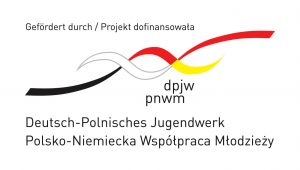 |
Another youth exchange with Germany with a new partner, a school from Prüm, is in preparation. The town is located in the south-west of the country in the holiday Eifel region.
The first organizational meeting and language animation workshops prepared by PNWM and intended for organizers of youth meetings are behind us.
Our school has been cooperating with PNWM for over 15 years. Youth participating in international exchanges receive funding from PNWM for the costs of the exchange, and teachers receive substantive and practical help. For which we thank you.
Students interested in the project are invited to J.
Applications are accepted by: prof. Aleksandra Mach and prof. Agnieszka Kudyba



